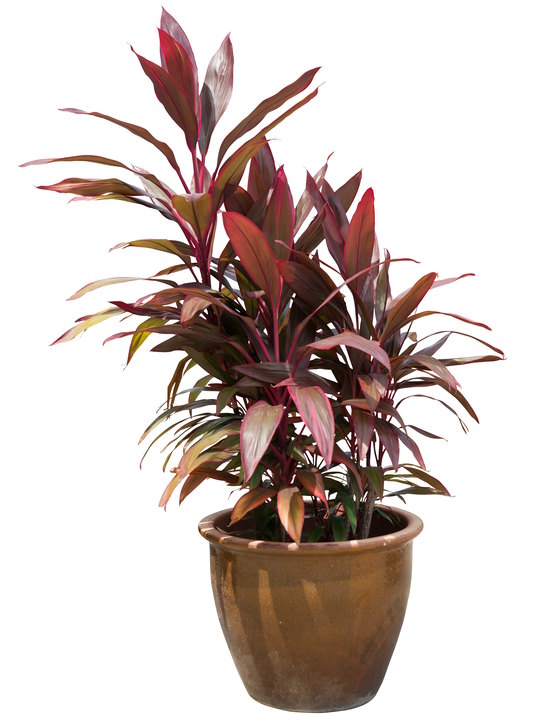Hawaiian Ti Plant Care
Ti plant makes a stunning accent, lending a breezy, tropical feel to a sunny room. Some are all-green, but the most sought-after Cordyline fruticosa varieties are streaked, splashed, or edged with spectacular color.
Here you'll discover how to grow these Pacific island natives indoors, including when to water, how much sunlight it wants, and why you want to boost the humidity.
Get to Know Ti Plants
Its broad leaves grow up to 2 ft (60 cm) long and are carried on upright stems that emerge from a narrow, central stalk. As ti plant grows, it naturally drops its lower leaves, becoming more tree-like with a trunk topped with a cluster of colorful foliage.
Some ti plants have solid green leaves, but the most popular houseplants include varieties with red, pink, cream, orange or copper variegation.
Does it bloom? In the wild, ti plants will produce pink or yellow flower spikes, but don't expect them when grown indoors.
Clean leaves. Wipe leaves gently with a damp cloth or spray with a fine mist of room-temperature water to keep them clean. Cleaning the leaves has another advantage -- it helps to prevent spider mites that love dry conditions.
Repot young ti plants in spring when their roots have filled the container. Move it to a pot only 1-2 inches larger. Be sure to use a pot with a drainage hole to prevent root rot. Older, larger ti plants can be top-dressed instead.
How to Top Dress: Remove the top 2-3 inches of soil and replace with fresh soil every couple years. Take care not to harm any roots that may be near the surface.
How big does ti plant get? Indoor plants may reach a height of 3-5 ft (90 cm-1.5 m).
Too tall? Prune it. You can control ti plant's height by cutting it back. New branches often grow from the base of the plant after pruning. Use sharp pruners to avoid tearing the stems.
 Red Ti Plant Image © Johannesk
Red Ti Plant Image © JohanneskHawaiian Ti Plant Varieties
Many named Cordyline fruticosa cultivars are available to choose from, including some with pink, red and orange streaked leaves.
- 'Tricolor' is a common variety with pink, red and cream variegation.
- 'Rededge' has a compact growing habit with red-bordered leaves.
- 'Red Sister' is another popular variety heavily streaked with red.
Buying tip: Hawaiian ti plant is formerly known as Cordyline terminalis and is sometimes still labeled with that name. However, its correct botanical name is Cordyline fruticosa.
Problems, Solutions and Answers for Your Ti Houseplant
Brown leaf tips on Cordyline fruticosa is often caused by low humidity. It's easy to boost the humidity around this houseplant with a cool-mist room humidifier.
Crinkled leaves can be a symptom of dry conditions. Potting mix that is allowed to dry out or low indoor humidity will cause problems for ti plant. (See "water" and "humidity" care tips below.)
Variegated leaves that revert to green are not getting enough sunlight. Several hours of bright sunlight each day will maintain colorful leaves.
Something bugging your ti houseplant? Watch for spider mites. If the leaves look dull and speckled, or you see fine webbing between leaves or stems, your houseplant may have an invasion of these tiny critters. Isolate an infested plant and clean ti leaves with warm, soapy water. Also keep an eye out for scale insects. Scale are round, brown bugs, typically found on the underside of leaves. Insecticidal soap will control them.
How to Care for Ti Plant Indoors
Light: Bright, indirect light. Leaves that lose their color and variegation aren't getting enough light. Moving the plant near a window where it gets bright, filtered light is ideal.
Water: Keep soil evenly moist spring through fall. In winter, allow the top inch (2.5 cm) to dry out between waterings. Cordyline fruticosa is sensitive to fluoride and chlorine that's often in tap water. It's a good idea to use rainwater or distilled water. If that's not practical, allow tap water to sit for 24 hours so that the chemicals in it will dissipate.
Humidity: Aim to maintain 50-60% relative humidity around ti plant. This tropical native prefers moist air, especially in the hot summer months. Dry air will cause leaf tips to turn brown. Keep ti plant away from drafts and heat/AC vents. A cool-mist room humidifier works best to add humidity around your Cordyline plant. It also loves to be misted.
Temperature: Average to warm (65-85°F/18-29°C) room temperatures. It will tolerate a minimum winter temperature of 60°F/16°C.
Soil: Peat moss-based mix, such as African violet potting mix.
Fertilizer: Spring through fall, feed every 2 weeks with a balanced water-soluble fertilizer, diluted by half. Choose one that includes micronutrients -- a magnesium deficiency will cause leaves to turn yellow. In winter, feed monthly.
Propagation: These are easy to grow from cuttings. Take 4 in (10 cm) stem tip cuttings in spring and root them in moist potting mix. Keep young ti plants warm and raise the humidity around them.


